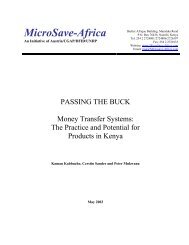You also want an ePaper? Increase the reach of your titles
YUMPU automatically turns print PDFs into web optimized ePapers that Google loves.
As business picked<br />
up, <strong>DAI</strong> moved into<br />
new digs at 1823<br />
Jefferson Place, N.W.,<br />
Washington, D.C.<br />
(center).<br />
10<br />
<strong>DAI</strong>’s clients at USAID demonstrated patience,<br />
confidence, and loyalty during and after the<br />
study. Two <strong>of</strong> them, Jerry French and Harlan<br />
Hobgood, were closely engaged with the study<br />
as it unfolded, and when <strong>DAI</strong> was running short<br />
<strong>of</strong> time and money, they extended the contract<br />
and found the extra funds that helped the study<br />
team reach the finish line. Like the postman who<br />
brought the check to pay for the Land Rovers,<br />
French and Hobgood were vital to <strong>DAI</strong>’s<br />
survival at a critical time. They also stepped up<br />
to defend the quality <strong>of</strong> the work, which was<br />
published in two volumes by Westview Press in<br />
1976, and was widely read in donor agency and<br />
academic circles.<br />
The Strategies study also had important things<br />
to say about project design. Up to that time, the<br />
usual approach to project planning resembled<br />
an architect’s blueprint—a detailed plan covering<br />
all contingencies from beginning to end. But<br />
these plans rarely worked in practice due to<br />
complications that inevitably arose. <strong>DAI</strong>’s analysis<br />
posited that projects worked best when they<br />
followed a “process approach” that created<br />
space for managers and project participants to<br />
deal with unanticipated events, and the likelihood<br />
that some interventions might initially fail,<br />
but could be adapted or redesigned during the<br />
project. Philosophically, the process approach<br />
embraced disciplined learning and experimentation,<br />
with course corrections being the norm,<br />
rather than the exception (as would be the case<br />
in a traditional project design). As Mickelwait<br />
described it, “Instead <strong>of</strong> preparing a blueprint,<br />
we start a program with a known goal and we<br />
find the answer as we go along.” <strong>DAI</strong>’s team<br />
argued that the process approach was also<br />
more likely to produce benefits that would be<br />
self-sustaining after the project terminated. <strong>DAI</strong><br />
did not invent these concepts, but in Strategies,<br />
<strong>DAI</strong> posed the right questions and came up with<br />
answers that USAID as the client, and many<br />
others in the development community, found<br />
persuasive.<br />
The small farmer study proved to be a turning<br />
point for <strong>DAI</strong>. “After that,” said Mickelwait,<br />
“people started to value our expertise, and we<br />
were in high demand.” The company began<br />
paying salaries and moved into more sizable<br />
quarters, a townhouse at 1823 Jefferson Place<br />
in Washington. It was still something <strong>of</strong> a shoestring<br />
operation. “Don Mickelwait and Charlie<br />
Sweet did everything from editing to bookkeeping<br />
to writing and signing checks,” recalled<br />
Craig Olson.



